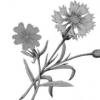Major oil palm : Motherland - Africa, Western Guinea, where you still collect crops with wild palm trees and get oil in the villages in traditional methods.

Guinea oil palm (Elaeis Guineensis) gives the most record harvest Among all oilseeds - 4-8 tons of oil from hectare per year!
But the Guinean oil palm has certain disadvantages. It grows exclusively in the warm wet equatorial climate between 18 ° North and South latitude. Square, suitable for growing oilseed palm, are very limited.

Oil palm - the most yield palm
In addition, this plant does not multiply vegetatively - palm you can grow only from seeds.

For 4-6 years, oil palm is growing, forming the outlet of the leaves, and only after that the barrel forms. Maximum fruiting starts from 15-20 years after sowing and continues approximately before 70 years.
Therefore, large groves of oil palm often belong to royal surnames and are inherited.
From the 15th century Palm tree began to grow in different parts of Africa, Southeast Asia and Latin America.
In 1870, oil palm For the first time was brought to Malaysia, applied as a decorative plant, decorated the streets of cities, and since 1917 she began to grow for commercial purposes.
Currently, Malaysia is the largest manufacturer and exporter of palm oil in the world.
Malaysia and Indonesia mainly specialize in cultivation of a palm tree hybrid, which is called "Tener". This variety gives about 4 tons of palm oil from each hectare, approximately 0.5 tons of palm core and 0.6 tons of cake.

Mallet Palma "Tener"
Palma reaches maturity in 3 years and fruits for 35 years. It gives the largest yield of oil in the calculation of the hectare compared to other agricultural crops.
Palm fruits grow large clusters, reaching weights 10-20 kilograms and about 2 thousand separate fruits. Palm oil is obtained from pulp, enveloping fruits, in a simple way: the fruits are boiled, pressing and pressed.

The pulp contains about 49% of palm oil, and the kernel is about 50% palmomania.

Palm "Tener" Begins to be froning 30 months after landing, and up to eight years, the yield is constantly increasing. Then five years yield remains on the same level. From 13 years, the yield gradually falls. By 25 years, plantation should be updated.

Oilseed palm is the most damned, as it gives a harvest 1 time in 20 days. That is, every 20 days need to collect new ripe fruit. Given that there are few workers, and they go gradually throughout the forest Palm, it is very important to not shoot them down, because the palm will begin to grow new flowers and fruits only after cutting the old one.
And, therefore, 20 days are counted after harvesting. And when there are failures, for example, the workers did not come out due to the rainstorm or for another reason, the entire cyclicity is knocked down. They climb on palm trees with the help of "cats", the chainsaw spill the nozzle, and they fall to the ground.

Palm oil It is one of the most ancient vegetable oils applied by man for cooking.
Palm oil is already used over 5000 years.
Palm oil is extracted from the fruits of oilseed palm, namely the pulp of fruits, which are first pressed, and then boiled. They grow mainly in tropical countries, in particular in West Africa.

In natural form, the product is a liquid substance, has an orange-yellow color and has a pretty pleasant aroma and a sweet taste. At temperatures below thirty degrees oil becomes hard reminiscent of Margarine structure.

Palm oil - the hardest vegetable oil
Palm oil is the only one in the world, which is called solid vegetable oil , in composition similar to animal fats.
Palm oil consists mainly of saturated fatty acids that differ the ability to store for a long time without changing its properties.
In its composition, the oil contains palmitic acid in huge quantities, but, despite this, there are also other rich and unsaturated fatty acids, in particular, stearin, olein, arachnaya, linoleic, Miristinova, Laurinovaya, etc.
In addition, the oil contains vitamins E, D, K, lecithin, phytosterols, squalene, coenzyme Q10, magnesium, phosphorus, etc. This product is quite calorie, the energy value is about 900 kcal per 100 g of product.
Today, palm oil in terms of production and consumption in the world - oil number 1.
The main consumers of palm oil are developed countries - Europe, America, Japan.
Why did palm oil get such widespread?
At first It is stored for a long time without changing taste and, accordingly, allows producing products with longer periods of implementation. Palm oil in the box can be stored at room temperature for 1 year, and it does not change its properties, does not bounce, unlike sunflower oil.
Secondly , Palm oil is very cheap, as the harvest is removed almost every day.
And thirdly, This oil is amenable to hydrogenation, in the process of which moves from a liquid state into solid. The resulting mass can be added anything - it is cheap (for example, compared to milk fat) and conveniently. And these qualities, of course, immediately appreciated manufacturers of products.

Palm oil - and solid and liquid
Palm oil is divided into Technical and food - solid and liquid, groups - White, yellow, red palm oils.

Elite grade - red palm oil
Red palm oils are "cream" palm oil, "elite". Next, the industrial oil is pressed - for mass production of products, (Lushin, Dashik, chips, etc.), and only then low-grade technical oil.
Oil remove from palm seeds . It's called core Palmov , it is brighter palm and reminds coconut. There are other types of palm oil.
In the field of culinary palm oil Upon use, you can compare with coconut oil. Confectioners in one voice argue that this product is simply indispensable in the production of their products, especially the one that is intended for long-term storage.
It is used in the production of margarine, other substitutes of natural cream oil, is an ingredient in the manufacture of condensed milk, crackers, crackers, chocolate, cheese, bread, ice cream, cakes, cakes, confectionery, and many other products.
Unique designation: african oilseed palm (plant)
Designation: african oilseed palm
% D0% B4% D0% B5% D0% B9% D1% 81% D1% 82% D0% B2% D0% B8% D0% B5% D0% BF% D0% BE% D0% BA% D0% B0% D0 % B7% D0% B0% D1% 82% D1% 8C% D0% BA% D0% BB% D0% B8% D0% B5% D0% BD% D1% 82% D0% BA% D0% B0% D1% 82 % D0% B0% D0% BB% D0% BE% D0% B3% D0% BA% D0% BB% D0% B0% D1% 81% D1% 81% 5B\u003e (\u003e% D0% A1% D1% 83% D1% 89% D0% BD% D0% BE% D1% 81% D1% 82% D1% 8C% D1% 80% D0% B0% D1% 81% D1% 82% D0% B5% D0% BD% D0% B8% D0% B5Stitude ⇔ Plant
Text:
Oil palm , or African oilseed palm , or Eleis Guinea (Lat. Elaeis Guineensis) - the plant of the Palm family ( ARECACEAE.), kind of genus oil palm ( Elaeis.).
The birthplace of this plant is the coastal areas of Equatorial West Africa from 16 ° C. sh. Up to 15 ° Yu.Sh. Cultivated, except for Africa, and other countries with tropical climates (Malaysia, Indonesia, etc.) to obtain valuable food and technical oil.
Botanical description
Morphology
In a wild form, the oilseed palm is a tree up to 20-30 m high, it rarely happens in the culture above 10-15 meters. The trunk appears only on the fourth-sixth year of life, and under the woods of the forest sometimes only after 15-20 years. The diameter of the trunk in an adult tree reaches 25 cm.
Et al.) To obtain valuable food and technical oil.
In a wild form, the oilseed palm is a tree up to 20-30 m high, it rarely happens in the culture above 10-15 meters. The trunk appears only on the fourth-sixth year of life, and under the woods of the forest sometimes only after 15-20 years. The diameter of the trunk in an adult tree reaches 25 cm.
Ecology
Wild-growing palm trees bloom and produce fruit only for the 10-20th year of life, in the culture of the plant begin to be fruit on the 3-4th year after planting. Maximum yield reaches aged 15-18 years, the life of this plant is 80-120 years old.
Oilseed palm trees grows in a hot and wet equatorial climate, the optimal average annual temperature for this plant is 24-28 °. Optimal annual precipitation: 1500-3000 mm.
It is also very light-headed, development is significantly delayed and the yield falls in conditions of even minor shading. As the observations showed, in the rainy season, with insufficient solar lighting, more male inflorescences are formed, and intensive lighting contributes to the emergence of female inflorescences.
To soils, the oilseed palm is rather undemanding and can grow almost on any types of soils of the tropical zone.
Fruit Classification
On the structure of the fetus, it is customary to divide all the variety of forms of oilseed palms for 3 types:
Application
Of the fruits of oil palm, two types of oil are obtained:
Cultivation
Oil from the fruits of this plant was manufactured for a long time. A jug with traces of palm oil was discovered in archaeological excavations of African graves belonging to the third millennium BC. e. However, it began to cultivate it on an industrial scale only in the 20th century, when companies producing margarine and soap are interested in oil from its fruits. In 1911, a large-scale breeding of oil palm in Indonesia began, and in 1919 - in Malaysia. Also were significantly expanded area occupied by oil palm in Africa. Now the oilseed palm has become one of the leading oilseeds in the world. In 1988, global oil production from fruits of oilseed palm was 9.1 million tons and every year it increases everything.
Melted palm implies seeds. To stimulate the germination of seeds, they are exposed to elevated (37-40 °) temperature. After germination, the seeds are sown in nurseries. From one hectare of the nursery receive up to 20 thousand seedlings, it is enough to plant 60-130 hectares of industrial plantations.
Increased yields are achieved by the introduction of modern intensive cultivation technologies instead of outdated, used for a long time by the local population in Africa, as well as the removal of new, more yields and giving a greater output of the oil of hybrids and varieties of oil palm.
Notes
Literature
- Wulf E. V., Maleeva O. F. World resources of beneficial plants. - L.: ed. Science, 1969.
- Oil palm - article on the website Ukraoconsalt
Links
- Oil palm - article from the Big Soviet Encyclopedia (Verified June 16, 2010)
Wikimedia Foundation. 2010.
- Gordon, Alexander
- Clement Ohridsky
Watch what is "oil palm" in other dictionaries:
oil palm - Oil palm. Oil palm, Elaeis Guineensis, Palma of Eleis. It is common in the coastal areas from Senegal to the Nile basin, in Chad and the CAR, on the Western shores of Lake Mobutu Seis Seko and Nyasa (Malawi). Most ... ... Encyclopedic Directory "Africa"
Oil palm - Tree of the family palm trees. In the western part of Equatorial Africa. Cultivated in tropics, extracting from octoplodnikov t. Palm oil, and from seeds of naternal oil used in food ... Big Encyclopedic Dictionary
Oil palm - (Elaeis), genus plant ses. Palm. 2 species, in the tropics of the south. America and Africa. Naib, known African M.P. Guineensis (E. Guineensis). The trunk is wicked. 15 20 (Sometimes up to 30) m. Leaves Curizes, for. up to 7 m. One-bedroom plant, but usually on one ... ... Biological Encyclopedic Dictionary
oil palm - Gvinėjinė AlyvPalmė Statusas T Sritis Vardynas APIRZATIS AREKINIų ŠEIMOS ALIEJINIS, VAISTINIS AUGALAS (Elaeis Guineensis), Paplitęs Afrikoje. Atitikmenys: lot. Elaeis guineensis; Elaeis Melanococca Angl. African Oil Palm; Oil Palm Vok. ... ... Lithuanian Dictionary (Lietuvių žodynas)
oil palm - Tree of the family palm trees. In the western part of Equatorial Africa. Cultivated in the tropics, mining the so-called palm oil from the oloplodnikov, and from seeds of naternal oil used in food. * * * Oil palm oil palm, ... ... encyclopedic Dictionary
oil palm - AlyvPalmė Statusas T Sritis Vardynas Arecaceae Šeimos Augalų Gentis (Elaeis). Atitikmenys: lot. Elaeis Angl. Oil Palm Vok. Ölpalme Rus. Lenk oil palm tree. Olejowiec Ryšiai: Susijęs Terminas - Tikroji AlyvPalmė Susijęs ... ... DEKORATYVINIų AUGALų VARDYNAS.
Oil palm - (Elaëis Jacq.) The genus of cider palms, distinguished by an abundant content of oil in the pulp of their fruits and gives the so-called. Palm oil. The trunk of these palm trees or lying, or a reprehensive, covered with flakes and sheet scars; At the top of the trunk beam ... Encyclopedic Dictionary F.A. Brockhaus and I.A. Ephron, absent. Côte d "Ivoire (Ivory Coast) is a small West African country. An interesting flora and fauna of the country. In the cat-d" Ivoire a lot of tropical vegetation. In the north and in the center of the country lies ... Buy for 49.9 rubles electronic book
On Venezuelan peach Palma Peaches, of course, do not grow. Its eighteen meter barrel and even the leaves are covered with very sharp needle-like spines that protect greeted fruits from people and animals.
Egg-shaped bright red or orange-yellow fruits with a small peach or apricot hanging huge bunches similar to grapes. The meaty outer part of the fetus to taste resembles chestnut and if it is booed in salt water, it turns out a delicious dish rich in vitamins. Sometimes these fruits are roasted and eaten with a molasses or watering sugar syrup. In Central and South America, peach palm trees plant whole plantations.

In Upper Egypt grows dum-Palma (in other places it is called ginger palm). From other palm trees, it is distinguished by an interesting feature. In the tree 10-12 meters, 3-4 branks grow high. Each of them ends with a bunch of fan-shaped leaves, between which flowers appear: on the same tree - women's, on the other - men's. In female trees, flowers are replaced by large clusters of beautiful shiny yellow-brown fruits. In one cluster there are up to 200 pieces. Ginger palm - The most important source of the poor in Egypt (eating a fibrous tormenting husk of fruits, which is like a ginger gingerbread).

In wetlands and flooded lowlands of tropical America, Africa and Madagascar is growing palm raffia, from the sweet juice of which you cook wine. Rafia fruits and top kidney are used in food like a vegetable, and oil is pressed from the seeds.
Another genus of wine palm trees - sUBEY. It combines honey or wine, palm, elephant and Chilean wonderful. They grow in the mountains along the Pacific coast of Chile to 1200 meters altitude.
Their smooth 25-meter trunks with a diameter near the meter serve as a source of producing a sweet juice up to 400 liters from one adult tree, which, in turn, is used to prepare the molasses (hence the name honey palm tree) and wine. The fetus 4-5 centimeters with edible pulp looks like coconut. The leaves are used for the manufacture of fibers, and also serve as roofing material.

The main source of vegetable oil in the tropics - the fruits of coconut and oilseed palm trees. Oil palm Growing in the western part of Equatorial Africa. On the trunk height of about 30 meters, carrying over 150 three-meter centers, hang the brushes of fruit-fire. One such brush consists of 600-800 fruits and weighs up to 25 kilograms. In the fruit seeds contain about 50% of the so-called palm oil used for the production of margarine.
Do you know that Fatherland palm trees are divided into men's and female? Male copy has a different type of flowers, which makes it possible to distinguish it from the female "individual." Even with deep antiquity, they knew that for a good harvest you need men and women's chipsticks. For several tens of female - one men's. One palm can give a quarter ton of dates.
Palmary is perfectly adapted for life in the desert: it can be protected not only from heat, but also from the cold too. Additional protection provide dead leaves. By the way, fresh leaves of palm trees are very durable and residents of the appropriate latitudes make clothes. Thus, people are well protected from the scorching sun and dust. In very hot weather, Palma grows only at night, resting day.
But how does the palm tree in the desert cost without water? Fortunately, it does not grow without water. The reality is that the finishes are growing only where the groundwater is suitable quite close to the surface, and with their powerful, long roots of the palm can reach them. Surrounded and an oasis is formed, the joy of those who travel through dry areas. You, if you decide to grow a domestic palm tree at home, you can not worry - in our latitudes, even in the largest heat, the china will feel perfectly.
Of the five thousand varieties of dates, everything can be divided into three groups: dry, semi-dry and juicy. Naturally, juicy is the most expensive and tasty, but in many indicators they inferior dry. The second are known for the fact that they are well strengthening the walls of the vessels, they have antioxidant and anti-radical activity.
In the Venezuelan peach palm peaches, of course, do not grow. Its eighteen meter barrel and even the leaves are covered with very sharp needle-like spines that protect greeted fruits from people and animals.
Egg-shaped bright red or orange-yellow fruits with a small peach or apricot hanging huge bunches similar to grapes. The meaty outer part of the fetus to taste resembles chestnut and if it is booed in salt water, it turns out a delicious dish rich in vitamins. Sometimes these fruits are roasted and eaten with a molasses or watering sugar syrup. In Central and South America, peach palm trees plant whole plantations.
In the Upper Egypt, the Duma Palma grows (in other places it is called ginger palm). From other palm trees, it is distinguished by an interesting feature. In the tree 10-12 meters, 3-4 branks grow high. Each of them ends with a bunch of fan-shaped leaves, between which flowers appear: on the same tree - women's, on the other - men's. In female trees, flowers are replaced by large clusters of beautiful shiny yellow-brown fruits. In one cluster there are up to 200 pieces. The ginger palm tree is the most important source of poor nutrition in Egypt (eating a fibrous tormenting husk of fruits, which is like a ginger gingerbread).
Duma Palma - the only branching palm tree in the world
In wetlands and flooded lowlands of tropical America, Africa and Madagascar, Palma Rafia is growing, from the sweet juice of which wine is preparing. Rafia fruits and top kidney are used in food like a vegetable, and oil is pressed from the seeds.
Another genus of wine palm trees. It combines honey or wine, palm, elephant and Chilean wonderful. They grow in the mountains along the Pacific coast of Chile to 1200 meters altitude.
Their smooth 25-meter trunks with a diameter near the meter serve as a source of producing a sweet juice up to 400 liters from one adult tree, which, in turn, is used to prepare the molasses (hence the name honey palm tree) and wine. The fetus 4-5 centimeters with edible pulp looks like coconut. The leaves are used for the manufacture of fibers, and also serve as roofing material.
The main source of vegetable oil in the tropics - the fruits of coconut and oilseed palm trees. Oil palm grows in the western part of Equatorial Africa. On the trunk height of about 30 meters, carrying over 150 three-meter centers, hang the brushes of fruit-fire. One such brush consists of 600-800 fruits and weighs up to 25 kilograms. In the fruit seeds contain about 50% of the so-called palm oil used for the production of margarine.
In Oceania, along with coconut palm, giving milk and oil, grows breadwinner. Children call all kinds of trees of Artocarpus Family Family. They fruit "loaves" weighing up to 12 kg! In the pulp of oval fruits, starch accumulates, turning with ripening in ... dough. "If anyone can plan a cereal tree, then he will make more in order to feed his descendants than Helborob. Life in the sweat of his facial processing his field .. "- wrote James Cook.
Usually bread trees are fruit for 70-75 years. On one tree, 700-800 "breads" ripen annually. The fruits are filled with sweet pulp. Beverages are made of unripe fruits, and something similar to bread is baked from ripe. Impressive the fruits of the Indian Bread Wood - to the meter in the diameter! The branches would not stand such a cargo, so "Karavai" grow straight on the trunk. In the African grain tree of traclialia, the fruits are smaller - to half a meter in diameter and weighing up to 14 kg. At Madagascar, the Patriarch of Bread Trees was preserved - 20 m height, trunk girth 50 m.
And from the starch Sagovy Palm, growing on New Guinea, make pancakes. Palma blooms on the 16th year of life, her truth, cut down, before flowering, when in its core the greatest amount of starch. The core is removed, pushed through a small sieve on a hot metal surface and made Sago, from that palm and is called sage.
Without any processing, you can use the milky juice of the nearest dairy tree - Venezuelan Galaktodendron. In composition, it is close to cow's milk and resembles cream with sugar! And if the juice boost, the delicious curd mass is formed.
At Madagascar, you can admire a stunning tree from the Bemponia family with bizarre fruits. It is called sausage, because on its branches there are many brown randomly hanging on long fruits sausage fruits. Each such "sausage" can be about half a meter and a diameter of 10 cm. However, so-called Aucubu Japanese. Its leathery leaves are covered with golden yellow spots and dots, partly resembling fat pieces on a cut sausage. Similarity, however, quite remote.
The eastern coast of Africa is the firmware of strange, peculiar forms of plant life. Here on the stony slopes of the mountains, you can meet a cucumber tree (Dendrosicyos Socotrana) - a plant with spiny wrinkled leaves, spikes, similar to ordinary cucumbers fruits and thick, swelling from the Milky Juice, consisting of a soft whitish cell tissue that is easily cut with a knife. This is the only tree in the pumpkin family.
On the coast of the Guinean Gulf, the palm tree, thickened nuts of nuts, is growing and is almost no different from the butter of flavoring.
There are plants - "lollipops". For example, the leaves of Paraguayan shrub Stevia more than 300 times sweeter than sugar, and the leaves of mexican sugar herbs are 1000 times. Red berries of grassy plant Toyumatus Dannels from African Savannah Sugar Sugar 2000 times, and red berries dio-corrugated cumminia from forests of Nigeria and other West African countries - 3000 times. In West Africa, the sweetest plant grows and the sweetest plant - a shrub kethemph containing the substance of Tummatin, superior to sugar sweets 100,000 times!
On the Oceania islands there is a view of tropical trees - "Cakes". They grow yellowish fruits into abundance, which to taste resemble sweet pastries.
Candy tree, or a Japanese raisin tree, is a representative of a family of crash, native of Japan and China - Khovnia Sweet. If you're accurate, then in fact they are dry, and the taste of this plant candy on an amateur: it resembles an sophisticated raisin inedible, but twisted axis holding their inflorescences juicy and fleshy. Each tree can give 35 kg of "chocolates" or sweet, with the taste of Roma.
In the forests, the Calir-Canda plant is growing, called the local inference to "fooling the stomach". I eaten 1-2 leaves, a man feels satiety for a whole week, despite the fact that there are no nutrients in the leaves. Thanks to the property of creating the illusion of the satiety of pills and infusions from the leaves of Calira Kanda, they recommend people wishing to get rid of excess weight.
Such a plant as Palma personifies his squeezing, solar start, fame and honesty. The straight trunk of palm trees symbolizes Triumph, blessing and victory. The constancy of the palm trees in its irremorated foliage, the permanent greenery gave rise to tie the tree strength with the victory symbol. Not in vain a palm branch for a long time awarded the winner on a par with a laurel wreath. Palma among the peoples of the territories on which it grows is a tree of life, self-reproducing like androgin.
An image of a palm tree without fruits symbolizes the male beginning and in many cultures is associated with a phalking symbol - the basis of male power. Palm tree with dates symbolizes the feminine and fertility.
Palma and young and in an old age, bringing a large amount of fruit became a symbol of prosperity and longevity in old age.
Different countries endow palm with their own symbolism, so in China, palm shows - dignity, fecundity and care from affairs, in Arabia Palma is a tree of life. In Christianity, Palma characterizes the righteous, immortality, the triumphant entry of Christ in Jerusalem, the Divine blessing, paradise, and the celebration of the martyr before death. Separately, palm branches designate triumph and glory, victory over death, sin and resurrection. Early Catholicism associated palm trees with burial and ranks this plant to the symbol of a person who made a pilgrimage. In Egypt, the palm is classified as calendar trees, which allow a new branch only once a month. In Greece, Palma is an emblem of Apollo Delo and Delphic.














